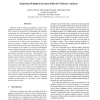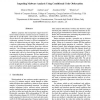85 search results - page 1 / 17 » Exploring Multiple Execution Paths for Malware Analysis |
SP
2007
IEEE
13 years 10 months ago
2007
IEEE
Malicious code (or malware) is defined as software that fulfills the deliberately harmful intent of an attacker. Malware analysis is the process of determining the behavior and ...
NDSS
2008
IEEE
13 years 10 months ago
2008
IEEE
Malware programs that incorporate trigger-based behavior initiate malicious activities based on conditions satisfied only by specific inputs. State-of-the-art malware analyzers ...
ICDCS
2008
IEEE
13 years 10 months ago
2008
IEEE
The possibility of using purely text stream (keyboardenterable) as carrier of malware is under-researched and often underestimated. A text attack can happen at multiple levels, fr...
SP
2009
IEEE
13 years 11 months ago
2009
IEEE
Malware authors have recently begun using emulation technology to obfuscate their code. They convert native malware binaries into bytecode programs written in a randomly generated...
SP
2010
IEEE
13 years 8 months ago
2010
IEEE
—To handle the growing flood of malware, security vendors and analysts rely on tools that automatically identify and analyze malicious code. Current systems for automated malwar...


